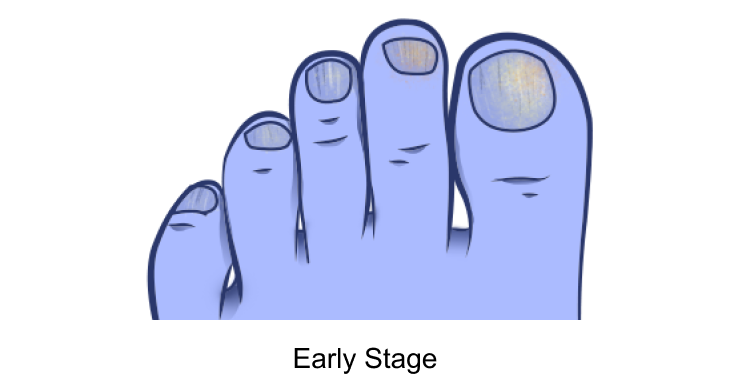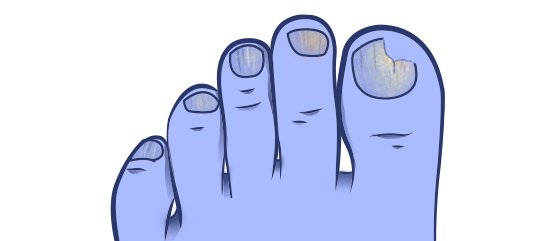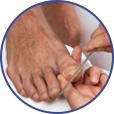HOME > ABOUT NAIL FUNGUS > SYMPTOMS OF NAIL FUNGUS
Symptoms of Nail Fungus

Nail fungus can quickly turn into a nasty infection if it is left untreated. While there are many signs of fungal infection, many of them are ignored until the problem has become severe. The earlier treatment is sought, the more quickly you'll eliminate the infection for good. Everyone experiences these symptoms in a unique way, but in most cases, the signs are very similar. Here, you'll learn about the initial signs of nail fungus.

Nail Discoloration
One of the first signs of a fungal infection is a visible discoloration of the nails. In fact, it's one of the first things you'll notice. Discoloration does not always affect the entire nail surface at first; sometimes, it appears as white streaks or spots. In some instances, the spots may darken, and many people mistake fungal infection for a nail injury. However, it takes time for an infection to get bad enough for a nail to darken and fall off. If you see spots, lines, or color changes, follow our treatment guide and get started right away.
Injury Leading to Fungal Infection
While fungus-related discoloration should not be confused with a nail injury, you should know that injuries can cause nail fungus. Trauma to the feet happens quite often. It can be sudden, like stubbing a toe, or it can happen over time, such as when shoes are too tight. An injury can crack a nail or cause it to separate from the nail bed, allowing fungi to take root. If you've injured yourself recently, pay attention to the appearance of your nails. If they're changing color, it may indicate the initial stages of a fungal infection.

Ridges
When you have a fungal infection, your nails' texture may change as well. One of the earliest changes to look for is ridges that span the nail's length. If your nails have become rough, it could mean anything from a vitamin deficiency to a skin condition. When ridges form, it typically means that the integrity and structure of your nails have changed. But, because nail ridges occur for several reasons, it's important to look for other signs of nail fungus as well.
Crumbling, Brittle Nails
Another textural change you might notice is how brittle your nails have become. Brittleness is a sign of weakness, and in severe nail fungus cases, your nails may even begin to crumble. An infection this severe can cause significant problems. First, these nails are more likely to snag on your socks and shoes, which can cause parts to be torn away. When this happens, you're vulnerable to a bacterial infection, bleeding, and other problems. Brittle nails may change in shape, becoming deformed over time. The more brittle your nails are, the stronger the infection is growing. However, starting treatment before your nails begin to crumble is easier and safer than waiting for them to become weaker.
Increased Thickness
If your nails are brittle and discolored, you likely have a mild fungal infection. But, when the nails begin to thicken, it's very important to find a treatment as soon as possible. When nails become thicker due to a fungal infection, it indicates that the fungus is alive and well. Thick nails aren't a sign of good health, and they can make it quite painful to walk or wear certain types of footwear. Thick nails are difficult to manage, but the harder you try, the easier it is to make a treatment work.

Signs of Nail Healing
Nail fungus grows slowly, and that means even the best treatment won't work in a day. However, by monitoring the appearance of your nails, you can notice results over time. First, you'll see the infected nail layers fall away. It's easy to trim them with clippers as the healthy nail grows in. Not only does this remove the infected nail parts, it makes it harder for the fungus to continue to grow. As the affected nail grows out, you'll see signs of healthy regrowth. Your nails' color and texture should eventually return to normal, and if the fungus made your nails thick, they'll gradually thin out. Nails will become stronger, while feeling less rigid and brittle. All of the signs of nail fungus will clear away as the nails heal, and when the new nails grow in, they'll look healthy, strong, and attractive. While healthy regrowth may take a while, seeing positive results is encouraging and it tells you that your treatment is working.
In Closing
Nail fungus isn't a dangerous condition, but it can affect your self-confidence. By looking for the earliest signs and symptoms of infection, you can stop nail fungus in its tracks. Check out our treatment guide and product comparison section to learn the best ways to beat toenail fungus.
Know your nail fungus

Knowing the symptoms, causes, and treatments is key to managing and preventing this condition.
Get rid of nail fungus

Maintain good hygiene, use antifungal treatments, and seek professional help if needed.
What to buy

Many nail fungus treatments exist. We reviewed the pros and cons of common over-the-counter options.

Your Source for Clear,
Healthy Nails. Expert Reviews,
Tips & Solutions. Empowering
You to Eliminate Nail Fungus
for Good!
Disclaimer: This website and its contents are owned, operated, and sponsored by GG Healthworks Inc, the manufacturer and distributor of EmoniNail. GG Healthworks Inc has no affiliation with and is not sponsored by, owned by or in any way endorsed by any of the other brands, companies, or trademark owners featured on this site. The content on this site, including comparisons, charts, tables, articles, and other content are made for illustration and entertainment purposes only, and shall not be relied upon for accuracy or for any other purpose. While we take measures to ensure the accuracy of the information provided herein, such measures may not be sufficient so we encourage our site’s visitors to conduct their own research and to not exclusively rely on the information contained herein.